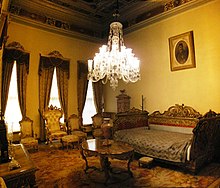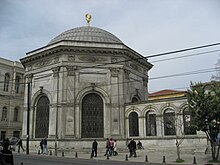Abdülaziz


|

|
|
|
Coin 10 Para 1864 (1280AH) with the tughra Sultan Abdülaziz
|
||
Abdülaziz (born February 8, 1830 in Istanbul , † June 4, 1876 in Istanbul's Çırağan Palace ) was the 32nd Sultan of the Ottomans . His reign fell during the Tanzimat reforms . He was the first Ottoman ruler to visit other European countries. In the first few years under his rule (1861–1876), reform policy dominated. In recent years there has been a state crisis, culminating in uprisings in some provinces and in national bankruptcy. In the end, the sultan was deposed and murdered.
Life
Abdülaziz was the second son of Sultan Mahmud II. His mother was Pertevniyal Valide Sultan , a native of Wallachia , who died in 1883. Abdülaziz was brought up in the sultan's palace and, as is customary for Ottoman heirs to the throne, lived in isolation from the public.
Era of reform policy
On June 25, 1861, he succeeded his brother Abdülmecid I on the throne. Like his predecessors, Abdülaziz continued the domestic reform course and the rapprochement with Europe. In 1856 he confirmed the Hatt-ı Şerif of Gülhane (1839) and lowered his civil list from 75 to 12 million piasters . His son Yusuf Izzettin Efendi was born in 1857, his son Abdülmecid II in 1868 and his son Şehzade Mehmed Seyfeddin Efendi (mother: Gevherî Vâlide Sultan ) in 1874 .
The modernization of the Ottoman army created new financial burdens . Several bonds were issued for financing .
Politically, his government was heavily burdened by the uprising in Crete from 1866 to 1869, the uprising in Bosnia and Herzegovina (1875), the Bulgarian April uprising of 1876 and the striving of Serbia and Romania for complete independence, but also by repeated outbreaks of Muslim fanaticism. In 1869 it was possible to reoccupy Yemen .
Under Abdülaziz, Mehmed Fuad Pascha and Mehmed Emin Ali Pasha had a central influence on politics. A sign of rapprochement with Europe was the visit of the Sultan to the Paris World Exhibition in 1867. The 47-day trip to Europe led Abdülaziz u. a. to London , Paris , Vienna and Koblenz . In Koblenz, Abdülaziz met the Prussian King Wilhelm I. At the invitation of the French President Napoleon III. to the world exhibition, to which he invited all European heads of state, Mehmed Ali Pasa announced at home and abroad that the sultan was also invited. This announcement followed the invitation from the French Emperor, making the trip indispensable. Thus the Sultan, also under the influence of Ali Pasa, who felt himself drawn to European culture, was obliged to make this journey successfully. Sultan Abdülaziz saw the trip to Europe as contradicting a caliph's national and Islamic identity and tried to distance himself.
The reforms in 1864 included the lifting of previous censorship and the legal equality of foreigners. An amended provincial order followed in 1863. In 1868 a Council of State and a Court of Cassation were established. To train lawyers, a new law school was founded in 1870, which soon overtook the traditional madrasas . For the Young Turks , who criticized the government especially from exile, the reforms did not go far enough.
State crisis, dismissal and death
After the death of Mehmed Fuad and Mehmed Emin Ali, Abdülaziz appointed Mahmud Nedim Pasha as Grand Vizier in 1871 . Instead of his nephew Murad, who was determined by the old order of succession, the sultan tried to have his son Yusuf İzzedin appointed heir to the empire. In order to prepare for this, he had granted the viceroy of Egypt the right of birthright as early as 1865 . He even entered into negotiations with Russia over a coup d'état with Russian help in order to overturn the old order of succession.
In 1875 the situation came to a head with the looming national bankruptcy. The modernization of the army , but also the increasingly luxurious lifestyle of the sultan and his building projects, including the extensive renovation of the Çırağan Palace, contributed to this . In 1875 there were uprisings in Bosnia and Herzegovina , followed by the Bulgarian April uprising in 1876 . In the capital there was an uprising against Mahmud Nedim on May 11, 1876. Abdülaziz dismissed him, but was forced to abdicate on the night of May 29-30, 1876 by Hüseyin Avni Pascha , Midhat Pascha , Mütercim Mehmed Rüşdi Pascha and Süleyman . On June 4, Abdülaziz was murdered in Çırağan Palace on their orders. It was pretended that he cut his own artery with scissors . In 1881 the pashas Midhat, Nuri and Mahmud, who were still alive, were sentenced to death for the murder of Abdülaziz, but were not executed. A few days after the sultan's murder, Avni Pasha was again murdered by Abdülaziz 'brother-in-law, Prince Hasan-Bey Barakay and brother of his fifth wife, Neşerek Kadın Efendi. Prince Barakay tried to avenge the death of his sister by murdering the Pashas, who had also fallen victim to those Pashas.
Others
Sultan Abdülaziz was a lover of the fine arts. In 1876 he supported the construction of the Richard Wagner Festival Theater in Bayreuth with a contribution of around 70,000 euros (based on today's purchasing power). However, he did not live to see the opening of the Festspielhaus. He was also a great artist in painting and drawing ships. The Armenian-Russian painter Iwan Konstantinowitsch Aivazovsky also reported that the sultan's skill in drawing was unique.
He also composed classical music. His orchestral composition Invitation à la Valse is well known , an arrangement by Arthur Kulling for a small orchestra.
Donated medals
literature
- Enver Ziya Karal: ʿAbd al-ʿAzīz. In: The Encyclopaedia of Islam. New Edition . Volume 1, Brill, Leiden, p. 56 f. (English).
- Klaus Kreiser, Christoph K. Neumann: Small history of Turkey. Stuttgart 2003, ISBN 3-15-010540-4 ; Pp. 330-338.
- Cevdet Küçük: Abdülaziz. In: Türkiye Diyanet Vakfı İslâm Ansiklopedisi. Volume 1, TDV Yayını, Istanbul 1988, pp. 179-185 (Turkish).
Web links
Individual evidence
- ↑ "The Turks are coming!": Exotic and erotic: Mozart in Koblenz and the longing for the Orient in art; Catalog for the exhibition in the Middle Rhine Museum Koblenz, 2006, ISBN 3-931014-70-3
- ↑ Kadir Misiroglu: Bir Mazlum Padisah: Sultan Abdülaziz. Sebil Yayinevi Publishing House, Istanbul 2006, ISBN 978-975-580-026-4 , p. 282
- ↑ "Pasha a lazy, selfish man who likes to be served by his wife?"
- ↑ Mustafa Armağan: Osmanlı tarihinde Maskeler ve Yüzler. Timaş Yayınları, İstanbul 2007, ISBN 975-263-116-9 ( excerpt in German translation ( memento from January 4, 2016 in the Internet Archive )).
- ↑ Kadir Misiroglu: Bir Mazlum Padisah: Sultan Abdülaziz. Sebil Yayinevi Publishing House, Istanbul 2006, ISBN 978-975-580-026-4 , p. 74
- ↑ The Europeanization of Turkey began in the cultural field: especially in the 19th century - long before Kemal Ataturk ( Memento from April 12, 2013 in the web archive archive.today ) Turkey-Reisen-Hotels.de, 2009, accessed on March 1 2013
| predecessor | Office | successor |
|---|---|---|
| Abdülmecid I. |
Sultan and Caliph of the Ottoman Empire 1861–1876 |
Murad V. |
| personal data | |
|---|---|
| SURNAME | Abdülaziz |
| ALTERNATIVE NAMES | Abd ul Aziz |
| BRIEF DESCRIPTION | Sultan of the Ottomans |
| DATE OF BIRTH | February 8, 1830 |
| PLACE OF BIRTH | Istanbul |
| DATE OF DEATH | June 4, 1876 |
| Place of death | Çırağan Palace , Istanbul |




